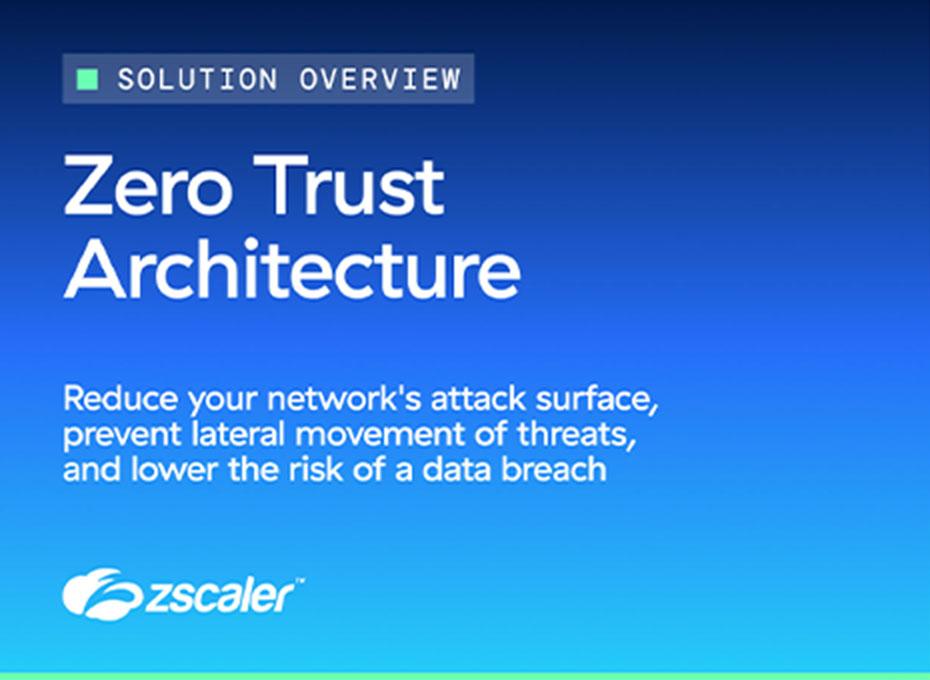/ What Is Zero Trust Architecture?
What Is Zero Trust Architecture?
Zero trust architecture is a security architecture built to reduce an organization’s attack surface, stop compromise, prevent lateral movement of threats, and block data loss based on the core tenets of the zero trust security model. Such a model puts aside the traditional "network perimeter"—inside of which all devices and users are trusted and given broad permissions—in favor of least-privileged, direct-to-app connectivity that forgoes network-based connectivity and provides granular microsegmentation.

The Importance of a Zero Trust Architecture
Organizations today are undergoing rapid digital transformation, driven by the adoption of cloud services, hybrid work environments, IoT devices, and SaaS applications. This evolution has rendered traditional network security architectures obsolete, exposing critical weaknesses in perimeter-based models built primarily with firewalls and VPNs. These legacy tools, designed for an on-premises world, have failed to keep pace with the agility and sophistication required by modern enterprises and actually increase cyber risk in today’s world.
A zero trust architecture (ZTA) has emerged as the solution to these challenges. By fundamentally rethinking security from a “never trust, always verify” perspective, zero trust overcomes the vulnerabilities of traditional architectures, ensuring secure, any-to-any connectivity for users, devices, workloads, IoT/OT systems, and B2B partners. This article explores why traditional architectures fall short and how zero trust transforms security to address the modern threat landscape.
The Shortcomings of Traditional Architectures
Perimeter-based architectures, often referred to as “castle-and-moat” models, were designed for an era when users, applications, and data primarily resided on-premises, connected to the corporate network. These architectures rely heavily on firewalls and VPNs to secure the network perimeter, while granting broad access to entities within the network. While this network-centric model worked acceptably well in the past, it is increasingly ineffective in today’s distributed, cloud-driven environments.
How Traditional Architectures Work
Traditional architectures revolve around the network, and their underlying tools like firewalls and VPNs aim to:
- Establish a security perimeter: Everything inside the network is assumed to be trusted, everything outside is deemed untrusted, and firewalls are essentially used as gatekeepers that separate the two.
- Backhaul traffic: Remote users must connect to centralized data centers and the network via VPN to access applications (including off-premises cloud apps), which adds latency and complexity.
- Scan traffic: Firewalls perform cursory scans of traffic entering and leaving the network, but they often let threats pass through defenses unseen and struggle to secure encrypted traffic.
The Four Main Weaknesses of Traditional Architectures
- Expanded attack surface: Firewalls and VPNs have public IP addresses by design to allow legitimate users access, but this also exposes the network to cybercriminals on the web. As organizations expand to more locations, clouds, and remote workers, it means more network extension, more firewalls and VPNs, and more public IP addresses. As such, the attack surface grows, increasing vulnerability.
- Compromise: Whether they are deployed as virtual or hardware appliances, firewalls lack the performance needed to inspect encrypted traffic at scale. With 95% of today’s web traffic being encrypted, that means organizations are blind to the majority of cyberthreats attacking them, because most threats are now hidden within TLS/SSL traffic.
- Lateral threat movement: Once attackers breach the perimeter, they can move laterally across the network, accessing connected resources. While network segmentation via additional firewalls is often a proposed solution, it only serves to increase risk, complexity, and cost, while failing to address the underlying problem: the firewall- and perimeter-based architecture itself.
- Data loss: Firewalls’ inability to inspect encrypted traffic allows sensitive data to leave the network undetected. Additionally, traditional tools are ill-equipped to secure modern data leakage paths, such as file sharing within SaaS applications.

How a Zero Trust Architecture Transforms Security
Zero trust is fundamentally different from traditional architectures. Instead of securing networks, it secures access directly to IT resources. Instead of governing access based on identity (which can be stolen), it governs access based on context and risk. A purpose-built cloud delivers the architecture as a service and at the edge, acting as an intelligent switchboard that enables secure, one-to-one connections between users, devices, workloads, branches, and applications—regardless of location. In other words, zero trust decouples security and connectivity from the network. With it, organizations can effectively use the internet as their corporate network.
The Principles of Zero Trust
- Verify identity: Every access request begins with authenticating the identity of the user or other entity that is attempting access.
- Determine destination: The zero trust platform identifies the destination being requested and ensures that it is legitimate and safe.
- Assess risk: AI/ML evaluates the context of the access attempt in order to understand risk, factoring in user behavior, device posture, location, and countless other variables.
- Enforce policy: Policy is enforced in real time on a per-session basis, granting, denying, or providing an intermediate level of access based on risk in order to ensure least-privileged access.
The Four Strengths of Zero Trust
- Minimizes the attack surface: By hiding applications behind a zero trust cloud, zero trust eliminates the need for public IP addresses and prevents inbound connections. Applications are invisible to the internet, reducing the attack surface.
- Stops compromise: Zero trust leverages a high-performance security cloud to proxy and inspect all traffic—including encrypted traffic—at scale. Real-time policies block threats before they reach users or applications.
- Prevents lateral movement: Zero trust connects users directly to applications, not the network. This granular segmentation ensures that attackers cannot move laterally between resources, effectively containing breaches.
- Blocks data loss: Zero trust architecture secures sensitive information across all potential data leakage channels—whether in motion to the web (even via encrypted traffic), at rest in the cloud, or in use on endpoints.
Zero Trust in Action: Securing Any-to-Any Connectivity
One of the defining strengths of zero trust is its ability to secure any-to-any connectivity. This means it can protect any of the entities that need access to your IT resources, including your:
- Workforce: Users can securely access the web, SaaS apps, and private apps without requiring network access
- Clouds: Zero trust secures communications for workloads in public, private, and hybrid cloud environments, and protects data at rest in your clouds and SaaS apps
- IoT/OT devices: Zero trust ensures secure connectivity for IoT and operational technology (OT) systems, protecting these critical assets from cyberattacks
- B2B partners: Third-parties like channel partners gain secure access directly to specific apps, without the need for VPNs or network-level access
Seven Elements of a Successful Zero Trust Architecture
Get a detailed rundown of zero trust from Nathan Howe, VP of Emerging Technologies at Zscaler.
Considerations When Evaluating Zero Trust Platforms
Adopting a zero trust platform is a pivotal decision for organizations seeking to modernize their security infrastructure. With numerous options available in the market, it’s essential to evaluate potential solutions against a set of key criteria to ensure the platform aligns with your organization’s unique needs. Below are some fundamental considerations to guide your evaluation process:
Comprehensive Coverage Across All Entities
A true zero trust platform must secure access for all critical entities within an organization, including the workforce, applications and clouds, IoT/OT systems, and partners. Ensuring unified protection across these vectors is crucial for maintaining a consistent and robust security posture without leaving gaps for attackers to exploit.
Financial Stability of the Provider
The financial health and longevity of the platform provider cannot be overlooked. A zero trust platform is often a mission-critical service, and organizations must ensure that their chosen provider has the financial stability and resources to continually invest in innovation while avoiding any interruption in service delivery.
Proven Track Record with Customers
A zero trust platform should come with a history of success across a diverse range of industries and customers. Look for documented case studies, endorsements, or testimonials that demonstrate the platform’s effectiveness in securing organizations of similar size, complexity, or sector as your own. Validation from real-world deployments helps instill confidence in its capabilities.
Scalability and Performance at a Global Level
Organizations today operate globally, requiring a zero trust platform that can seamlessly scale while delivering consistent performance. The platform must have the infrastructure to support users, applications, and workloads across multiple geographies with low latency, high availability, and reliable connectivity.
Resilience to Address the Unexpected
In an era of constantly evolving threats, resilience is non-negotiable. The platform must be capable of handling unexpected contingencies, whether it's a surge in user activity, emerging cybersecurity challenges, or unforeseen technical failures. A resilient zero trust solution ensures uninterrupted service, even under the most adverse conditions.
AI Integration for Enhanced Security and Efficiency
Lastly, as organizations evaluate zero trust platforms, it’s important to consider how artificial intelligence (AI) is integrated into the solution. Modern zero trust platforms, like the Zscaler Zero Trust Exchange, use AI and machine learning (ML) to optimize policy enforcement, detect anomalies, and streamline decision-making processes. AI enables organizations to respond to threats with speed and precision, setting the stage for future advancements in cybersecurity.
Evaluating zero trust platforms with these considerations will help ensure your organization selects a solution that is secure, reliable, and adaptable. As we move forward, AI’s role in enhancing zero trust will become an invaluable driver of innovation and efficiency.
The Role of AI in Zero Trust
Zero trust architecture is the ideal foundation for implementing AI-based security. This is because the massive volume of data that a zero trust platform processes as it handles customers’ traffic is ideal for training LLMs. In turn, AI enhances the capabilities of zero trust by imbuing them with greater intelligence, effectiveness, and automation. Zscaler, for example, integrates AI/ML throughout its Zero Trust Exchange in order to improve countless abilities like:
- Detecting and blocking threats: Machine learning models help to identify and mitigate sophisticated threats, such as zero day attacks, in real time.
- Automating segmentation: AI-Powered App Segmentation ensures applications are accessible only to authorized users, reducing the internal attack surface and the possibility of human error associated with manual segmentation.
- Discovering sensitive data: AI Auto Data Discovery automatically finds and classifies sensitive information across all possible data leakage channels.
- Enhancing user productivity: AI-Powered Root Cause Analysis automatically identifies the underlying problems causing user experience issues, enhancing productivity for the workforce and the IT helpdesk.
The Zero Trust Exchange connects and secures users, workloads, and devices over any network from any location.
Beyond Security: The Business Benefits of Zero Trust
In addition to reducing cyber risk, zero trust delivers several operational and financial benefits:
- Reduced complexity: By replacing firewalls, VPNs, and various point solutions with a unified, modern platform, organizations can simplify their IT environments.
- Cost savings: Eliminating legacy tools while simplifying security and networking reduces management overhead and lowers total cost of ownership (TCO).
- Enhanced user experience: Direct-to-app connectivity eliminates the latency associated with backhauling traffic, ensuring fast, seamless access for users and enhancing productivity.
- Enterprise agility: Zero trust is a flexible architecture that enables organizations to secure cloud applications and hybrid work, empowering them to adapt quickly and safely to changing business needs.
Conclusion
The rapid pace of digital transformation demands a security architecture that can keep up. Traditional perimeter-based approaches, with their inherent weaknesses, are no longer sufficient. Zero trust architecture, with its focus on secure, any-to-any connectivity and dynamic, context-based policies, offers a modern solution to today’s cybersecurity challenges.
By integrating AI into zero trust, organizations can further enhance their security posture, streamline operations, and improve user experiences. With the Zscaler Zero Trust Exchange, businesses can confidently embrace digital transformation while protecting their users, data, and applications—along with everything else in their IT ecosystem.
For organizations ready to take the next step, the path to zero trust starts with understanding its principles, strengths, and implementation strategies. Secure your future today with Zscaler.
Start Your Zero Trust Journey – Explore More
Suggested Resources
Frequently Asked Questions
Zero trust is a security framework that asserts that no user or application should be trusted by default. A zero trust architecture enforces least-privileged access controls, which establish trust based on context (e.g., user identity and location, the security posture of the endpoint, the app or service being requested) with policy checks at each step. Access requests—even from known individuals—are never granted until they pass strict authentication.
Zero trust is the future of security because the rise of cloud computing and remote work have made traditional security perimeters unreliable. Zero trust architecture adapts to dynamic modern work paradigms with stringent access controls, continuous monitoring, and data-centric security, providing stronger and more adaptive, proactive defenses against insider threats as well as the breadth of today’s advanced cyberattack techniques.
Implementing zero trust security takes time, but for modern organizations to survive and thrive, it’s a necessity. Zscaler breaks down the journey to zero trust into four steps:
- Empower and secure your workforce
- Protect your data in cloud workloads
- Modernize your IoT/OT security
- Engage your customers and suppliers securely
By taking these one by one—transforming your network and security along the way—you’ll attain a zero trust architecture that securely connects users, devices, and applications over any network, anywhere.
Read more in our dedicated article: How Do You Implement Zero Trust?

